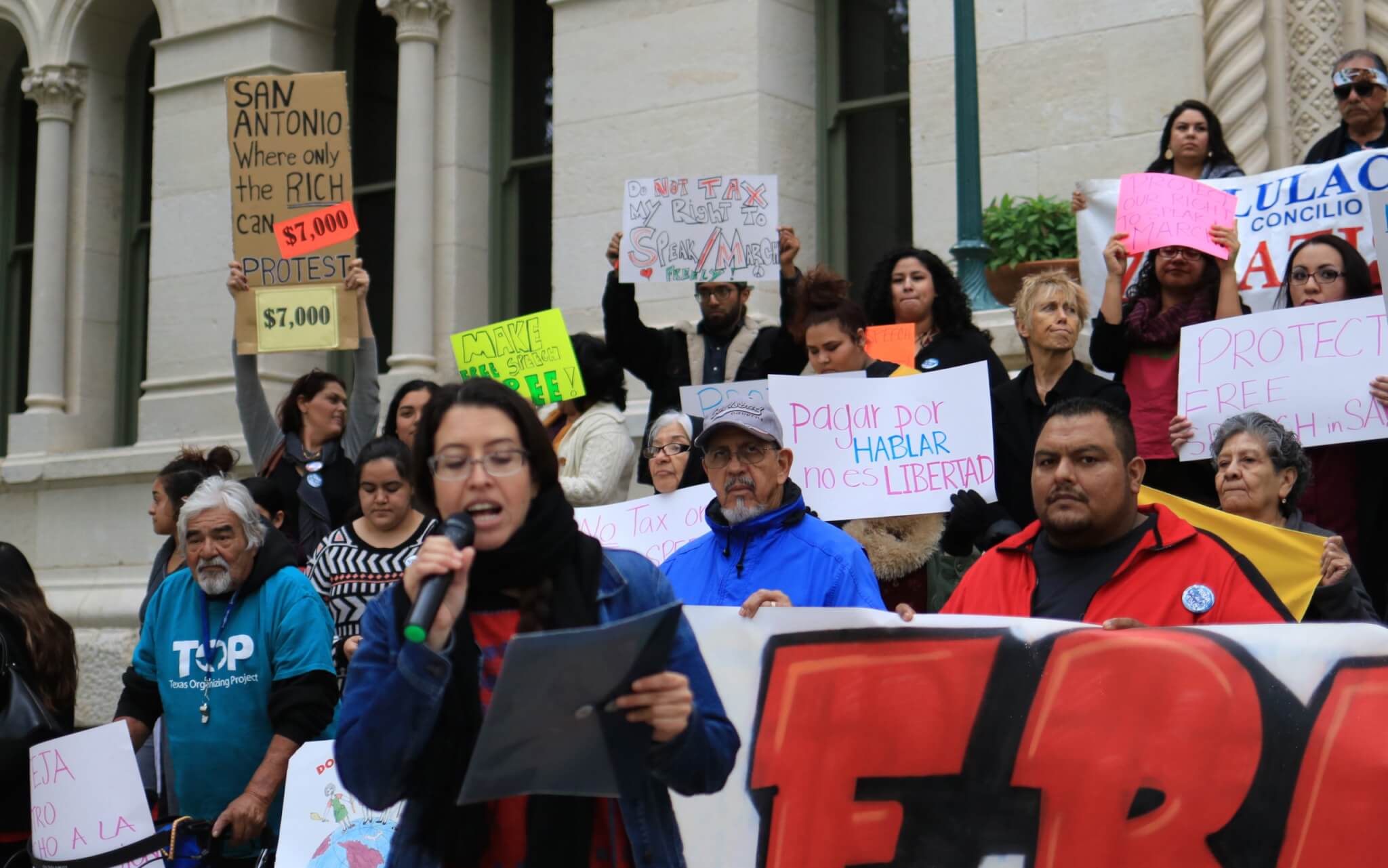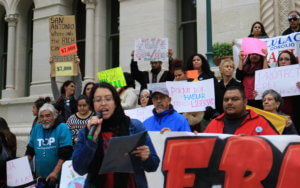

Sofia Sepulveda holds up her vertical card board sign as Joleen Garcia addresses city officials in front of City Hall.
Setting It Straight: This story has been corrected to reflect that the fee to assemble in the streets is not fixed.
In early November, Sofia Sepulveda gripped a vertical cardboard sign in front of City Hall, which read, “San Antonio where only the rich can protest.”
The sign referred to San Antonio’s 10-year-old parade ordinance, which requires San Antonians to pay a permit fee that can reach into the thousands of dollars to assemble in the streets. If the march is protected by the First Amendment, the city of San Antonio absorbs $3,000, and organizations pay the rest.
“Fee speech is not free speech,” chanted members of the San Antonio Free Speech Coalition on the steps of City Hall in 40 degree weather.
However, the fee has not dissuaded those who feel marginalized from saying what they have to say in city streets. This year, given this nation’s political climate, citizens have march much more frequently than in years past. Some of the issues they’ve railed against, single-payer healthcare, for example, relate to San Antonio’s economic segregation, which leads the nation according to some studies. People also have marched in support of women’s rights, the Black Lives Matter movement, Senate Bill 4, and Deferred Action for Childhood Arrivals.
Since 2007, many of those who have marched have demanded the city eliminate the fee, and, by early 2018, it might happen.
City officials told the coalition they plan to recommend to the City Council next week that the city pay for the cost of peace officers and barricades. The city staffers met with more than 100 people at a meeting organized by the coalition Tuesday night at the Esperanza Peace and Justice Center.
“Ma’am you are exactly right, it is an insignificant amount of revenue, and we’ll be recommending at City Council next week at B Session … that we wave that — there is no charge,” Deputy City Manager Eric Walsh told the coalition and others gathered at the Esperanza Center.
The crowd roared in applause and screams of praise in reaction to Walsh’s statement. District 1 Councilman Roberto Treviño sat in on the meeting, but as an observer, as the dialogue between activists and city officials continued.

Jessica O. Guerrero speaks at a meeting Tuesday night between city officials and the San Antonio Free Speech Coalition. Jose Arredondo / Folo Media
On Feb. 7, Treviño authored a City Council Consideration Request (CCR) to review the ordinance. He believes the current ordinance lacks clarity and discourages people from voicing their concerns.
“How are you supposed to know what your community wants if you don’t allow them to speak?” Treviño said in a previous interview. “The whole point is to try and find balance. We need public safety in everything that we do, but there are things in place that discourage activity.”
SAPD handles the permit applications, but the form isn’t available online or easily accessible. The city and activists agree the current application process is a major issue that causes confusion. Walsh said the city will recommend an online application, and suggested libraries as an alternate location for people with don’t have internet access.
Accessibility of information is an area Treviño said his office works on daily. In March, his push for the Spanish translations of City Council meeting agendas, memos and news releases was approved.
“Some of the agendas and meetings times are not easily found or accessible and we are making improvements every day,” Treviño said. “We will make sure that access to the information, the permits, all that is open and freely accessible, too.”
In recent years, organizations have assembled in the streets without the a permit. The day after President Donald Trump was sworn into office, Mujeres Marcharan organized a rally called “Women’s March Against Hate.” The peaceful, 1.6-mile march drew 1,500 people and went from City Hall to the West Side, guided by both the SAPD and the Brown Berets, a grassroots organization.
“There have been over 100 demonstrations in the last couple of years and we’ve had no major issues,” SAPD spokesman Sgt. Jesse Salame said. “Everybody has been well behaved and been very conscious of safety, and been very respectful to police.”

SAPD bike officers force an SB4 march to the sidewalk on Sept. 1 near Travis Park. Jose Arredondo / Folo Media
The fees pay for law enforcement to control traffic, close off streets, and, if necessary, place barricades. The ordinance also states that citizens are allowed to march on the sidewalks without a permit. During the single-payer healthcare protest in July, marchers stayed on the sidewalk and many activists felt controlled and even somber.
On Sept. 1, Barbie Hurtado, immigrants rights activist, asked 70-plus marchers holding anti-SB4 signs on East Houston Street, “Whose streets?”
“Our streets!” they responded.
The marchers flooded the streets of downtown and interfered with traffic. Neither law enforcement or city officials were informed. SAPD bike cops rode up to the crowd and formed a barricade using their bikes. They guided the activists to the sidewalk this way.
Activists say they feel safer on the streets than sidewalks when marching.
“Streets are safer physical spaces to march in as opposed to sidewalks because they don’t have the physical obstacles and space constraints that sidewalks do,” said Jessica O. Guerrero, San Antonio International Women’s Day March planning group member. “Sidewalks are often interrupted by planters, trees, light posts, badly placed benches. Plus, cracks and breaks, and misplaced or absence of ramps create dangerous obstacles for marches or processions to safely move through.”
Jonathon-David Jones, a Houston native and grassroots activists, helped organize a Black Lives Matter rally this summer at Travis Park, which served as space to grieve and discuss police brutality. He then led the attendees through the streets of downtown chanting “Black Lives Matter.”
Jones said laws, such as the current marching ordinance, are put in place to hinders people’s ability to speak out.
“It all ties into the same theme: This idea of control. And I’m of the belief that there is a difference between freedom and liberty — freedom is free, and liberty is freedom within these confines,” Jones said. “Being approached by an SAPD officer telling us, ‘Don’t do this, and don’t do that. Stand behind the barricade, this is a free speech space,’ is all apart of that running theme.”

Jonathon-David Jones leads the Black Lives Matter march on July 4 downtown. Jose Arredondo / Folo Media
The coalition requested that law enforcement not be involved with marchers’ decisions. SATX 4, a grassroots organization similar to Black Lives Matter, immigrant rights activists and the rest of the coalition said they are intimidated by law enforcement. They suggested march marshals and peacekeepers instead. City officials’ proposal entails street assembly that requires marchers and law enforcement to collaborate.
“You can’t not include the police department,” Walsh said to those at the meeting. “They are there to help you come up with a traffic safety plan.”
SAPD Capt. Robert Blanton and three other police officers sat beside the city officials. Blanton believes law enforcement doesn’t want to stifle people’s rights, but believes other citizens’ rights and safety are affected during street marches. He said the traffic division at SAPD is vital for the marches, but wants to have meetings with the organizations to be on the same page.
“We mentioned a feedback mechanism in the potential ordinance, and recurring quarterly meetings to discuss any issues,” Blanton said. “I think those are key things to create that dialogue and continue that dialogue.”
Walsh, City Attorney Andrew Segovia and other city officials will present the changes to the ordinance to City Council at 2 p.m. Wednesday in the Municipal Plaza Building, 114 W. Commerce St.
This article was originally published by the H.E. Butt Foundation’s Folo Media initiative in 2017.